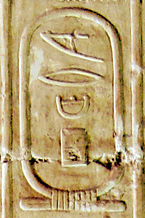Anedjib
| Anedjib | |||||||||||||||||||||||||||||||||||||||||||||||||
|---|---|---|---|---|---|---|---|---|---|---|---|---|---|---|---|---|---|---|---|---|---|---|---|---|---|---|---|---|---|---|---|---|---|---|---|---|---|---|---|---|---|---|---|---|---|---|---|---|---|
| Adjib, Enezib, Miebîdós | |||||||||||||||||||||||||||||||||||||||||||||||||
 Pharaoh Anedjib on a stone bowl fragment | |||||||||||||||||||||||||||||||||||||||||||||||||
| Pharaoh | |||||||||||||||||||||||||||||||||||||||||||||||||
| Reign | 8-10 years, ca. 2930 BC | ||||||||||||||||||||||||||||||||||||||||||||||||
| Predecessor | Den | ||||||||||||||||||||||||||||||||||||||||||||||||
| Successor | Semerkhet | ||||||||||||||||||||||||||||||||||||||||||||||||
| |||||||||||||||||||||||||||||||||||||||||||||||||
| Consort | Umm el-Qa'ab | ||||||||||||||||||||||||||||||||||||||||||||||||
| Dynasty | 1st Dynasty | ||||||||||||||||||||||||||||||||||||||||||||||||
Anedjib, more correctly Adjib and also known as Hor-Anedjib, Hor-Adjib and Enezib, is the
Name sources

Adjib is well attested in
Identity
Adjib's family has only partially been investigated. His parents are unknown, but it is thought that his predecessor, king
Reign
According to archaeological records, Adjib introduced a new royal title which he thought to use as some kind of complement to the
Clay seal impressions record the foundation of the new royal fortress Hor nebw-khet ("Horus, the gold of the divine community") and the royal residence Hor seba-khet ("Horus, the star of the divine community").[7] Stone vessel inscriptions show that during Adjib's reign an unusually large number of cult statues were made for the king. At least six objects show the depicting of standing statues representing the king with his royal insignia.[4]

Stone vessel inscriptions record that Adjib commemorated a first and even a second Heb Sed (a throne jubilee), a feast that was celebrated the first time after 30 years of a king's reign, after which it was repeated every third or fourth year.[8] But recent investigations suggest that every object showing the Hebsed and Adjib's name together were removed from king Den's tomb. It would seem that Adjib had simply erased and replaced Den's name with his own. This is seen by egyptologists and historians as evidence that Adjib never celebrated a Hebsed and thus his reign was relatively short. Egyptologists such as Nicolas Grimal and Wolfgang Helck assume that Adjib, as Den's son and rightful heir to the throne, may have been quite old when he ascended the Egyptian throne. Helck additionally points to an unusual feature; All Hebsed pictures of Adjib show the notation Qesen ("calamity") written on the stairways of the Hebsed pavilion. Possibly the end of Adjib's reign was a violent one.[3][6]
Tomb
Adjib's burial site was
The main chamber is surrounded by 64 subsidiary tombs which are interpreted as ancillary burials.
To date, the tomb has only been excavated once, by Flinders Petrie between 1899 and 1900. This is unlike the other tombs in the necropolis, which were excavated before Petrie by the Frenchman Émile Amélineau and subsequently by the German Archaeological Institute.

Finds associated to Anedjib
-
Stone vessel fragment bearing Anedjib serekh.
-
Serekh of Anedjib from an inscription.
-
Map of Anedjib's tomb in theUmm el-Qa'ab.
Bibliography
- Eva-Maria Engel. "The Royal Tombs at Umm el-Qa'ab," In: Archeo-Nil 18 (2008), p. 39.
- , pp. 12–13.
References
- ISBN 0-674-99385-3, page 33–37.
- ISBN 0-900416-48-3; page 15 & Table I.
- ^ ISBN 3-447-02677-4, page 124, 160 - 162 & 212 - 214.
- ^ ISBN 0-415-18633-1, page 78, 79 & 275.
- ^ ISBN 0-521-07791-5, page 27–31.
- ^ ISBN 0-631-19396-0, page 53 & 54.
- ISBN 90-429-1469-6, page 1137.
- ISSN 0344-385X, page 27-34.
- ^ W. M. Flinders Petrie, Francis L. Griffith: The royal tombs of the first dynasty: 1900. Part I. London 1900, Tafel LVX.
- ^ Günter Dreyer: Zur Rekonstruktion der Oberbauten der Königsgräber der 1. Dynastie in Abydos (Mitteilungen des Deutschen Archäologischen Instituts Kairo 47). von Zabern, Mainz 1991, page 56.
- ISBN 0-415-18633-1, page 16
- ZDB-ID 988141-4). Egypt Exploration Fund u.a., London 1901, S. 39, Tafel XLII (Digitalisierung).
- ISBN 0-415-18633-1, page 17.




